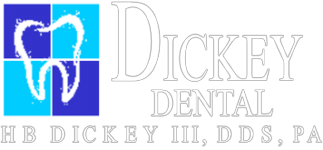Waiting for weeks with a temporary crown can be inconvenient and uncomfortable, especially for patients with busy schedules. Fortunately, advancements in dental technology have introduced a new era of convenience and precision with CEREC, or Chairside Economical Restoration of Esthetic Ceramics. CEREC technology allows patients at Dickey Dental in Rock Hill, SC, to receive high-quality, custom-made crowns in a single visit with Dr. Hugh Brad Dickey.
This innovative technology has redefined the experience of dental restoration, offering a streamlined process that maintains both comfort and aesthetics. Let’s explore how CEREC technology benefits patients seeking durable, natural-looking crowns—all in one day.
What is CEREC Technology?
CEREC technology utilizes computer-aided design and manufacturing (CAD/CAM) to produce dental crowns in-office. Unlike traditional crowns, which require multiple appointments and temporary crowns while waiting for an external lab to fabricate the permanent one, CEREC crowns are designed, created, and placed during the same visit. With the help of digital imaging, CEREC technology captures a precise image of the damaged tooth, which the software then uses to design a custom crown. This design is then milled on-site, producing a strong, ceramic crown that matches the color and shape of natural teeth.
Why Choose CEREC for Same-Day Crowns?
Opting for CEREC technology eliminates the need for temporary crowns, reducing overall treatment time and offering immediate results. But the benefits go beyond just convenience—CEREC technology enhances patient comfort, durability, and the aesthetics of the crown itself.
Convenience Without Compromise
One of the standout benefits of CEREC technology is the convenience it offers. For patients who lead busy lives or struggle to make multiple dental visits, the ability to receive a crown in a single appointment is a game-changer. Traditional crowns typically require two or more visits and a waiting period of a few weeks, during which a temporary crown must be worn. Temporary crowns are often prone to damage or discomfort, making the wait for a permanent crown inconvenient.
With CEREC, patients can avoid the hassle of temporary crowns and the disruption of scheduling multiple appointments. In a single visit, Dr. Hugh Brad Dickey can prepare the tooth, design the crown, and permanently place it, making it a seamless experience from start to finish.
High Precision and Customization
CEREC technology employs digital scanning, which captures highly detailed images of the tooth, ensuring a precise fit for the crown. Traditional methods often require messy impressions, which can be uncomfortable and may not always capture the tooth’s exact dimensions. Digital scans, on the other hand, eliminate human error and provide a level of accuracy that translates into a better-fitting crown.
This accuracy ensures that the crown integrates seamlessly with surrounding teeth, reducing the risk of gaps, discomfort, or future complications. A well-fitted crown not only enhances comfort but also improves long-term outcomes by minimizing wear on adjacent teeth and preventing issues like gum irritation.
Enhanced Comfort and Reduced Sensitivity
Temporary crowns can sometimes lead to gum sensitivity and discomfort. They may not fit as securely, causing shifting or discomfort when chewing. Because CEREC crowns are custom-fitted and placed immediately, they eliminate the need for temporary solutions and offer a comfortable fit from day one.
Patients often report less post-procedural discomfort with CEREC crowns compared to traditional crowns. The single-visit process reduces the chances of sensitivity or irritation that can arise from multiple dental procedures, making CEREC a favorable option for those with low pain tolerance or sensitive teeth.
Aesthetic Excellence
CEREC crowns are crafted from high-quality ceramic that closely mimics the look and feel of natural teeth. This ceramic material is durable and can be color-matched to surrounding teeth, ensuring a cohesive, natural appearance. Unlike metal or metal-ceramic crowns, which may cause discoloration or have visible edges, CEREC crowns blend seamlessly, enhancing the aesthetics of your smile.
For patients seeking restorative work on front teeth or in areas where appearance is crucial, CEREC crowns offer a significant advantage. The ceramic used in CEREC is also known for its translucency, which reflects light similarly to natural tooth enamel, creating a more lifelike appearance.
Durability and Longevity
While convenience and appearance are important, durability is paramount when choosing a dental restoration. CEREC crowns are made from a solid block of ceramic, which is known for its strength and resilience. Ceramic is not only durable but also resistant to staining, making CEREC crowns a long-lasting solution for restoring damaged teeth.
With proper care and regular check-ups, CEREC crowns can last for many years, providing reliable performance. Patients who maintain good oral hygiene and attend routine dental appointments can expect their CEREC crowns to have similar, if not better, longevity compared to traditional crowns.
Minimizing the Risk of Decay
Traditional crowns require a temporary restoration, which can sometimes trap food and bacteria if it doesn’t fit perfectly. These temporary crowns can create opportunities for decay and gum irritation, as they may shift or cause friction with surrounding teeth.
CEREC eliminates the need for temporary crowns, reducing the risk of decay or complications that may arise from prolonged exposure to bacteria. By receiving a permanent crown in a single visit, patients can enjoy peace of mind, knowing that their restoration is secure and that their tooth is protected.
Cost-Effectiveness Over Time
While the initial cost of CEREC crowns may be comparable to traditional crowns, the benefits in terms of time saved, reduced appointments, and minimized risk of complications often make it a cost-effective choice in the long run. Patients avoid the expense of multiple appointments, potential issues with temporary crowns, and the need for adjustments that can occur with traditional crowns.
The efficiency of CEREC technology also means fewer disruptions in your daily life, reducing time away from work or other responsibilities. Investing in a same-day crown may also lower the overall cost of dental care by preventing future complications that could require additional treatments.
Making the Choice: Is CEREC Right for You?
While CEREC crowns are an excellent option for many patients, Dr. Hugh Brad Dickey at Dickey Dental will assess each individual case to determine the best treatment. CEREC technology is particularly advantageous for those with busy schedules or those seeking a quick, effective solution for restoring their smile. However, patients with specific dental conditions or more complex cases may benefit from alternative approaches.
If you’re considering a crown and are interested in the convenience and durability that CEREC technology offers, a consultation with Dr. Dickey can provide a clear pathway to optimal oral health and aesthetics.
Embrace the Benefits of Same-Day Crowns
CEREC technology brings together convenience, accuracy, and aesthetics, making it a popular choice for those seeking a faster, more comfortable dental restoration. At Dickey Dental in Rock Hill, SC, Dr. Hugh Brad Dickey uses CEREC to provide patients with top-tier, same-day crowns designed for both beauty and strength. Say goodbye to the hassles of temporary crowns and multiple appointments and embrace a solution that’s as efficient as it is effective.
Sources:
- Otto, T., & De Nisco, S. (2002). Computer-aided direct ceramic restorations: a 10-year prospective clinical study of CEREC CAD/CAM inlays and onlays. International Journal of Prosthodontics.
- Bindl, A., & Mörmann, W. H. (2005). Clinical evaluation of adhesively placed Cerec endo-crowns after 2 years—a preliminary report. Journal of Adhesive Dentistry.
- Beuer, F., Schweiger, J., & Edelhoff, D. (2008). Digital dentistry: an overview of recent developments for CAD/CAM generated restorations. British Dental Journal.


